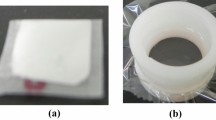Abstract
The Curie–Weiss law has been applied to develop a quantitative analytical method referred to as the “effective magnetic moment method” without the use of any reference material for determining the “amount of substance.” This nondestructive and non-separation analytical method was validated by using samples of gadolinium oxide (Gd2O3) mixed in silicon oxide. Prior to validation, the magnetic field strength, temperature, and magnetic moment [measured with a superconducting quantum interference device (SQUID) as magnetometer] were calibrated to improve the accuracy of results obtained by this analytical method, using a nuclear magnetic resonance probe magnetometer with a custom-made probe, a platinum resistance thermometer, and a standard reference material of known magnetic moment. For regression analysis of magnetic moment and temperature data, the values of three unknown parameters and their uncertainties were calculated by using a custom-made program based on the nonlinear least-squares method. In the validation results, the relative difference between the mass fractions of Gd2O3 in mixture samples obtained by this method and those obtained by gravimetric blending was approximately 2 %, when the mass fraction of Gd2O3 ranged from 0.04 kg kg−1 to 1 kg kg−1 and the mass of the sample ranged from 17 mg to 62 mg. The uncertainty of the mass fraction was approximately 5 %, as evaluated by this analytical method. A prevalent source of uncertainty in this method is the reproducibility of measured magnetic moments in the SQUID.







Similar content being viewed by others
References
JCGM 200 (2012) International vocabulary of metrology—basic and general concepts and associated terms (VIM) 3rd edn. Online available http://www.bipm.org/vim
International Organization for Standardization (2006) Reference materials—general and statistical principles for certification, 3rd ed. ISO Guide 35:2006. ISO, Switzerland, p 31
Milton MJT, Quinn TJ (2001) Primary method for the measurement of amount of substance. Metrologia 38:289–296
Shimizu Y, Ohte Y, Bao X, Otsuka S, Kitamaki Y, Ishikawa K, Ihara T, Kato K (2008) Development of certified reference materials of high-purity volatile organic compounds: purity assay by the freezing-point depression method Accred. Qual Assur 13:389–396
Matsumoto N, Kato K (2012) A quantitative magnetic analytical method using Curie’s law for a mixture of paramagnetic and diamagnetic substances. Metrologia 49:530–537
Kittel C (1996) Introduction to solid state physics, vol 14, 7th edn. Wiley, New York
Blundell S (2001) Magnetism in condensed matter. Oxford University Press, New York
McElfresh M (1994) Fundamentals of magnetism and magnetic measurements featuring quantum design’s magnetic property measurement system, quantum design, Inc.San Diego, CA, http://www.qdusa.com/sitedocs/appNotes/mpms/FundPrimer.pdf
Gans P (1992) Data fitting in the chemical sciences by the method of least squares. Wiley, Chichester, pp 30–34
Deming WE (1943) Statistical adjustment of data. Wiley, New York
International Organization for Standardization (2001), Gas analysis-comparison methods for determining and checking the composition of calibration gas mixtures, ISO 6143:2001 ISO, Geneva
Takikawa Y, Ebisu S, Nagata S (2010) Van Vleck paramagnetism of the trivalent Eu ions. J Phys Chem Solid 71:1592–1598
Bud’ko SL, Canfield PC (2006) Evaluation of a long-term temperature drift in a commercial quantum design MPMS SQUID magnetometer using Gd2O3 as a standard. J Mag Mag Mater 299:281–287
Mele P, Artini C, Ubalduni A, Costa GA, Carnasciali MM, Masini R (2009) Synthesis, structure and magnetic properties in the Nd2O–Gd2O3 mixed system synthesized at 1200°C. J Phys Chem Solid 70:276–280
Child HR, Moon RM, Raubenheimer LJ, Koehler WC (1967) J Appl Phys 38:1381–1383
Acknowledgments
We thank members of the Organic Analytical Division of NMIJ/AIST for fruitful discussions on this study. The help extended by Dr. Y Shimizu of NMIJ/AIST in performing measurements using the ultra-microbalance is greatly appreciated. A portion of this work was conducted at the Nano-Processing Facility (NPF), supported by the NPF and AIST. This work was supported by JSPS KAKENHI Grant Number 24750077 (Grant-in-Aid for Young Scientists (B)).
Author information
Authors and Affiliations
Corresponding author
Rights and permissions
About this article
Cite this article
Matsumoto, N., Shimosaka, T. Validation of a quantitative analytical method based on the effective magnetic moment and the Curie–Weiss law. Accred Qual Assur 20, 115–124 (2015). https://doi.org/10.1007/s00769-014-1101-4
Received:
Accepted:
Published:
Issue Date:
DOI: https://doi.org/10.1007/s00769-014-1101-4




